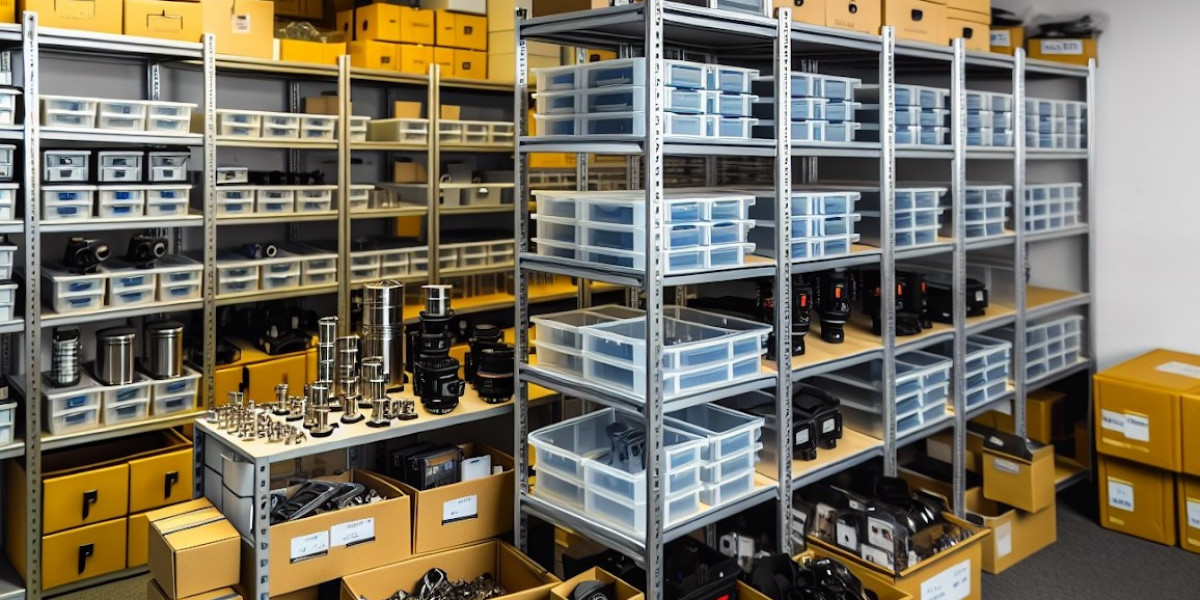The rapid growth of e-commerce has revolutionized industries across the globe. As online shopping continues to rise, it has significantly impacted how warehouses are designed and managed. Traditional warehouse models are evolving to meet the demands of faster deliveries, higher volumes, and more complex inventory systems. In this article, we will explore how e-commerce has influenced warehouse design and storage solutions, from the integration of automation to the optimization of racking and shelving systems.
The Shift to Faster Fulfillment: Redesigning Warehouses
E-commerce has brought the need for faster order fulfillment to the forefront. As consumers demand quicker delivery times, warehouses must adapt to meet these expectations. This has led to changes in warehouse design, prioritizing speed, efficiency, and accessibility.
Key Changes in Warehouse Layout:
Smaller, More Localized Warehouses: To meet the demand for rapid delivery, e-commerce companies are investing in smaller, strategically located warehouses closer to urban areas.
Increased Space for Picking Areas: More space is allocated for picking and packing zones, where items are retrieved and prepared for shipping quickly.
Automation Integration: Automated systems like conveyor belts, robotics, and automated guided vehicles (AGVs) are becoming integral to warehouse design, helping to move products more efficiently.
The need for speed has forced a reevaluation of traditional storage strategies, leading to significant improvements in warehouse layout and organization.
The Rise of Automation in Warehouse Design
With the increasing demands of e-commerce, automation has become a key player in optimizing warehouse design. Automation reduces the need for manual labor, speeds up processes, and enhances accuracy, making it an essential aspect of modern warehouses.
Benefits of Automation:
Faster Picking and Packing: Automated systems can locate and retrieve products more quickly than human workers, improving order fulfillment times.
Improved Accuracy: Automation reduces human error, leading to more accurate inventory management and fewer mistakes in order processing.
Cost Efficiency: Although initial investment in automation can be high, it reduces labor costs and increases warehouse throughput, providing a long-term return on investment.
As e-commerce continues to grow, the role of automation in warehouse design will only increase, with businesses striving to achieve maximum efficiency.
Optimizing Storage Solutions for E-Commerce: The Role of Racking and Shelving
One of the most significant impacts of e-commerce on warehouse design is the way goods are stored. The traditional shelving and storage methods are no longer sufficient to handle the volume, variety, and speed required by modern e-commerce operations. Racking and shelving systems must be optimized to ensure maximum storage capacity and accessibility.
Types of Racking and Shelving for E-Commerce:
Push-back Racks: These racks allow for high-density storage while providing quick access to goods. They are ideal for warehouses that handle a large number of products with varying demand levels.
Flow Racks: This type of racking system uses gravity to move items to the picking area, optimizing space and improving picking efficiency.
Pallet Racking: Heavy duty shelving solutions like pallet racks are essential for warehouses dealing with large or bulky items, providing the strength and durability needed for efficient storage.
As e-commerce businesses grow and diversify their product offerings, they require increasingly sophisticated storage systems to accommodate different types of products and facilitate faster picking.
The Need for Flexible Storage Systems
E-commerce warehouses must be adaptable to handle fluctuations in demand, seasonal spikes, and changing inventory. Flexible storage systems are critical to keeping up with these challenges.
Features of Flexible Storage:
Modular Racking Systems: These systems can be easily adjusted or reconfigured to accommodate changing inventory needs or seasonal product surges.
Adjustable Shelving: Adjustable shelving allows warehouses to customize storage heights and shelf spacing based on product size, optimizing space usage.
Multi-Tier Racking: Multi-tier systems maximize vertical space, offering additional storage levels without requiring a larger warehouse footprint.
Flexible storage solutions enable e-commerce businesses to scale their operations quickly and efficiently, making them crucial in the modern warehouse design landscape.
Handling a Diverse Inventory: Customization in Warehouse Design
E-commerce companies often carry a vast range of products, each with unique storage requirements. As a result, warehouses need to be designed with flexibility to accommodate a wide variety of goods, from small items like electronics to bulky furniture.
Key Design Elements for Diverse Inventory:
Specialized Storage Areas: Custom-designed areas for storing fragile or temperature-sensitive items, such as electronics or perishable goods, are becoming more common.
Optimized Picking Systems: Warehouse design must include systems that can handle both small, high-turnover items and large, low-turnover products.
Mixed Storage Solutions: E-commerce warehouses often combine different racking and shelving methods, such as shelving for small items and pallet racking for bulkier products.
By customizing storage solutions, warehouses can accommodate the diverse range of products typically found in e-commerce operations, optimizing efficiency and inventory management.
The Shift Toward Smaller, Multi-Purpose Warehouses
As e-commerce continues to expand, the trend of smaller, multi-purpose warehouses is becoming more prominent. This shift reflects the growing demand for quicker delivery times and the need to manage inventory closer to customers.
Benefits of Smaller, Multi-Purpose Warehouses:
Proximity to Customers: Smaller warehouses located near urban areas help reduce shipping times and costs, which is a critical factor for e-commerce companies.
Versatility: Multi-purpose warehouses can be used for both storage and fulfillment, improving the overall efficiency of operations.
Cost Savings: Smaller warehouses require less investment in space, and when designed efficiently, they can still handle a high volume of products.
This new approach to warehouse design is part of the effort to make e-commerce more efficient and cost-effective, helping businesses meet the rising expectations of consumers.
Enhancing Warehouse Safety with E-Commerce Growth
As e-commerce businesses grow, so do the complexities and risks associated with warehouse operations. Ensuring safety in these environments is more important than ever. Warehouse designs are now incorporating safety features to protect workers and products alike.
Key Safety Features in Warehouse Design:
Safety Barriers and Guardrails: These physical barriers help prevent accidents by clearly marking walkways and protecting workers from forklifts and other heavy equipment.
Ergonomic Storage: Adjustable shelving and racking systems allow for safer handling of goods, reducing the risk of injury for warehouse staff.
Automated Safety Systems: Some advanced warehouses use sensors and automated systems to detect potential hazards and alert workers, helping prevent accidents before they occur.
As e-commerce continues to shape warehouse design, maintaining a safe environment will be a top priority for businesses.
Implementing Technology for Inventory Management
E-commerce businesses rely on sophisticated inventory management systems to ensure accurate stock levels and fast order fulfillment. These systems are closely tied to warehouse design, influencing how storage solutions are implemented and how goods are tracked.
Key Technologies for Inventory Management:
RFID and Barcode Scanning: These technologies allow for real-time tracking of inventory, improving accuracy and reducing errors in picking and packing.
Warehouse Management Systems (WMS): A WMS integrates with racking and shelving systems to automate inventory control and order fulfillment, improving operational efficiency.
Mobile Devices and Wearables: Workers are increasingly using mobile devices and wearable technology to access real-time information about inventory and order status, enhancing productivity.
By incorporating these technologies, e-commerce warehouses can streamline operations, reduce errors, and maintain optimal inventory levels.
Sustainability in Warehouse Design
Sustainability is becoming an essential consideration in warehouse design, especially as e-commerce companies face increasing pressure to reduce their environmental impact. Sustainable warehouse solutions are not only better for the environment but also improve long-term operational efficiency.
Sustainable Design Practices:
Energy-Efficient Lighting: LED lighting and motion-sensing lights help reduce energy consumption in warehouses.
Recycled and Sustainable Materials: Using sustainable materials for racking and shelving and other infrastructure elements reduces environmental impact.
Green Roofs and Solar Panels: Many modern warehouses are incorporating green roofs and solar panels to generate renewable energy and improve insulation.
Sustainability is an important factor in the warehouse design process, helping businesses reduce their environmental footprint while also cutting operating costs.
The Future of Warehouse Design in E-Commerce
The future of warehouse design is continually evolving in response to the changing demands of e-commerce. As technology advances and consumer expectations grow, warehouses will need to become more agile, efficient, and connected.
Future Trends in Warehouse Design:
Fully Automated Warehouses: Fully automated warehouses will become more common, with robots handling everything from picking to packing.
AI and Machine Learning: AI will help optimize inventory management, predict demand, and automate key processes.
Advanced Delivery Solutions: E-commerce companies are exploring new delivery methods, such as drones and autonomous vehicles, which will require further changes in warehouse design.
As e-commerce continues to expand, warehouse design will need to adapt to keep up with technological advancements and evolving consumer expectations.
Read Also:The Future of Warehouse Storage: Automation and Innovation
Conclusion
E-commerce has had a profound impact on warehouse design and storage solutions. From automation to innovative racking and shelving systems, warehouses are becoming faster, smarter, and more efficient. The integration of advanced technologies, sustainability practices, and flexible storage solutions is reshaping how warehouses are structured and how they operate. As e-commerce continues to grow, the future of warehouse design will be characterized by even greater innovation, with a focus on speed, accuracy, and adaptability.









